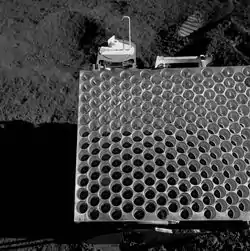MoonLIGHT
MoonLIGHT, also called Lunar Laser Ranging Retroreflector Array for the 21st Century (LLRRA-21), is a laser retroreflector to be deployed near the lunar south pole region. The reflector was planned to be launched in July 2020 as a secondary payload on the MX-1E lunar lander built by the private company Moon Express. However, as of February 2020, the launch of the MX-1E has been canceled. The fate of MoonLIGHT is unknown.
The laser-ranging experiment was developed as a collaboration primarily between the University of Maryland in the United States, and the Italian National Laboratories of Frascati to complement and expand on the Lunar Laser Ranging experiment started with the Apollo Program in 1969.
Overview


The principle of this laser ranging is based on laser pulses sent from a telescope on Earth to the retroreflector array on the Moon. The retroreflector (mirrors) send the pulse straight back to the originating telescope where the round trip time—and therefore the exact distance—is recorded. The reflector arrays are designed to allow more accurate measurements from Earth that will increase lunar mapping accuracy, will test principles of Einstein's general theory of relativity, and other theories of gravity. Researchers think these studies may also help understand the nature of dark energy.[1][2]
MoonLIGHT is a laser reflecting array to be deployed near the lunar south pole region. It was developed as a collaboration primarily between the University of Maryland and the Italian National Laboratories of Frascati.[1] Additional partners and collaborators include the Matera Laser Ranging Observatory of ASI, the University of Hannover (Germany), and the Czech Technical University (Czech Republic).[1] The experiment and agreement between the collaborators was announced on 15 May 2015.[1]
The reflector was planned to be a secondary payload on the MX-1E lunar lander built by Moon Express,[3] which was planned to be launched in 2020 with an Electron rocket.[3] An unrelated planned science payload on the same lander was the International Lunar Observatory.[4] The MX-1E lander was planned to land on the Malapert Mountain, a 5 km tall peak in the Aitken Basin region that has an uninterrupted direct line of sight to Earth.[5] The launch contract between Moon Express and Rocket Lab (manufacturer of Electron) was canceled sometime before February 2020. Moon Express does not, as of February 2020, anymore plan to launch MX-1E on an Electron rocket, thus leaving MX-1E and all its science payloads without a carrier rocket.[6] This leaves the fate of the science payloads hanging in the air.
This experiment will complement and advance the retroreflector experiments begun with Apollo 11 in 1969.[1] The team claims to have developed a new approach and technology that would increase the ranging accuracy by a factor of 100[2] by using new technology and methods to correct for libration and the thermal behavior and the optical performance.[7]
References
- Tune, Lee (10 June 2015). "UMD, Italy & MoonEx Join to Put New Laser-Reflecting Arrays on Moon". UMD Right Now. University of Maryland.
- Currie, Douglas; Dell'Agnello, Simone; Delle Monache, Giovanni (April–May 2011). "A Lunar Laser Ranging Retroreflector Array for the 21st Century". Acta Astronautica. 68 (7–8): 667–680. Bibcode:2011AcAau..68..667C. doi:10.1016/j.actaastro.2010.09.001.
- Boyle, Alan (12 July 2017). "Moon Express unveils its roadmap for giant leaps to the lunar surface ... and back again". GeekWire. Retrieved 15 March 2018.
- "Moon Express Announces Lunar South Pole Mission Technology Development Contract with International Lunar Observatory Association" (Press release). Moon Express. 21 July 2017. Archived from the original on 20 March 2018. Retrieved 21 March 2018.
- Nowakowski, Tomasz (12 August 2017). "International Lunar Observatory to offer a new astrophysical perspective". Spaceflight Insider.
-
- Moon Express [@MoonEx] (9 February 2020). "There is no upcoming launch with RocketLab. We contracted with RocketLab back in 2015 for a GLXP attempt. We are currently focused on efforts supporting NASA under our Commercial Lunar Payload Services (CLPS) contract" (Tweet). Retrieved 26 February 2020 – via Twitter.
- "MoonLIGHT: A USA–Italy lunar laser ranging retroreflector array for the 21st century." M. Martini, S. Dell'Agnello, D. Currie, G. Delle Monache, R. Vittori, J.F. Chandler, C. Cantone, A. Boni, S. Berardi, G. Patrizi, M. Maiello, M. Garattini, C. Lops, R. March, G. Bellettini, R. Tauraso, N. Intaglietta, M. Tibuzzi, etal. Planetary and Space Science. Volume 74, Issue 1, December 2012, Pages 276-282. doi:10.1016/j.pss.2012.09.006.